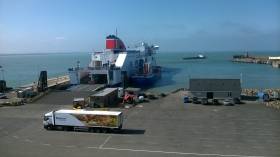Displaying items by tag: Timber Trade Growth
Cargoships at Rosslare As Timber Trade Set for Further Growth
#CargoRosslare – A pair of cargoships loaded with timber in Scotland docked at Rosslare Europort, where the outlook in this trade in 2016 is for further growth at the Wexford ferryport, writes Jehan Ashmore.
Cargoship, Ayress (1979/1,713grt) loaded in Ayr on the Forth of CLyde with round timber (i.e. logs) that was discharged yesterday at Rosslare. Following that call, the Islay Trader (1992/2,386grt) loaded with cargo from Campbeltown on the Mull of Kintyre was also unloaded at the Irish port.
The timber trade began slowly in 2013/2014, but in 2015 about 20,000 tonnes of logs were imported through Rosslare using 12 shipments. Typical loading trading ports are from Scottish west coast ports, mainly Ardrishaig and Sandbank, with the occasional shipment from Campbeltown.
Both short-sea coasters berthed at Fisherman’s Quay which is the westernmost of the quays, leaving the other two piers dedicated to ferry traffic serving Wales and France. Irish Ferries operate to Pembroke, Cherbourg and Roscoff and Stena Line to Fishguard and also to Cherbourg.
The south-eastern port is also to welcome business from the cruise industry, in which Afloat will have more in an update this weekend.
























































